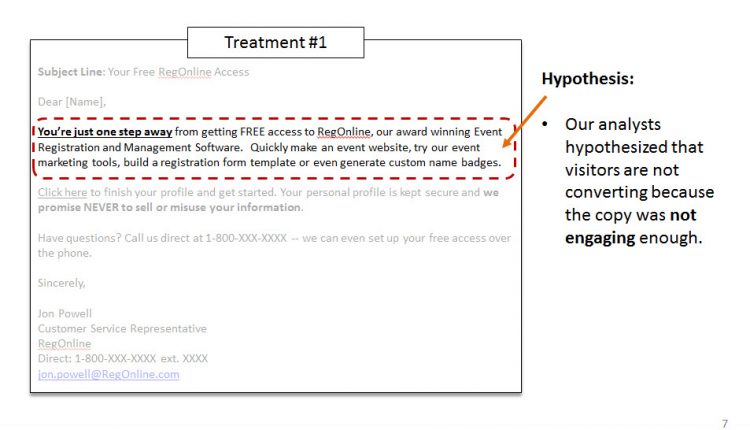Writing copy for an email is difficult enough – but what about tone?
Are you talking to your customers or at them? Do the offers in your emails entice or do they alienate?
Today’s MarketingExperiments blog post will share an experiment featured in our recent Email Copywriting Clinic, sponsored by Ongage, in which presenter Flint McGlaughlin, Managing Director, MECLABS revealed the results of an experiment on how tone affects conversion.
Our goal is to show marketers the effectiveness of your messaging is impacted by how customers perceive it.
So, let’s take a quick look at the test background …
Background: Active Network, a large event management software provider.
Goal: To increase total lead inquiries – phone calls and form sign-ups – from visitors who abandoned the free trial sign-up process.
Research Question: Which email tone will result in a higher rate of lead inquiries?
Test Design: A/B single factor split
Treatment #1
In treatment one, visitors who abandoned the free trial sign-up were sent an email that focused on the value
of the software.
Here’s a closer look at the email copy in Treatment #1:
Subject Line: Your Free RegOnline Access
Dear [Name],
You’re just one step away from getting FREE access to RegOnline, our award winning Event Registration and Management Software. Quickly man an event website, try our event marketing tools, build a registration form template or even generate custom name badges.
Click here to finish your profile and get started. Your personal profile is kept secure and we promise NEVER to sell or misuse your information.
Have questions? Call us direct at 1-800-XXX-XXXX – we can even set up your free access over the phone.
Sincerely,
[Name of Representative]
Customer Service Representative
RegOnline
Direct: 1-800-XXX-XXXX ext. XXXX
Treatment #2
The approach in Treatment #2 is engagement through addressing the elements of anxiety leading visitors to abandon the sign-up process.
Let’s look at the email copy in Treatment #2:
 Subject Line: Your Free RegOnline Access
Subject Line: Your Free RegOnline Access
Hi [First],
I noticed that you started the process of getting free access to RegOnline but weren’t able to finish. Are you concerned about giving out your phone number? Are you worried about high pressure sales tactics or mandatory contracts?
We believe our product sells itself, so we’re just here to provide you with whatever assistance you need in getting your event up and running – in whatever way works best for you. We promise NEVER to sell or misuse your information.
Call me direct at 1-800-XXX-XXXX and I can help get you rolling. If you’d rather just try again online, use this link instead.
Thank you in advance for your trust!
Sincerely,
[Name of Representative]
Customer Service Representative
RegOnline
Direct: 1-800-XXX-XXXX ext. XXXX
Side-by-side
Flint explained the difference in tone is ultimately a difference in hypothesis.
“The direct response tone in Treatment #1 gives you a good reason to start now and the second one is a helpful tone that’s focused on reducing your anxiety,” Flint said.ResultsThe marketers at Active Network saw a 349% increase in lead inquiry rate by addressing customer anxiety through the tone of the email copy.
What we can learn
The results of this experiment reveal two key principles Flint emphasized every marketer should understand when it comes to the medium of email:
- The goal of effective email copy is not to convince a customer to buy, but rather to serve a customer in a way that enables them to quickly make the best decision.
- To make the best decision, a customer must be able to understand and accept a series of logical premises that lead to an ultimate conclusion – to click.
To learn more about how you can improve your email copywriting, watch the full, free video replay of Email Copywriting Clinic: Live, on-the-spot analysis of how to improve real-world email campaigns.
Related Resources
Conversion Rate Optimization: Building to the Ultimate Yes







Thank you for sharing these insights.
It goes to show that awareness of, and relevancy to, where in the buying process a client/customer is, matters more than anything else.
If someone abandons a signup process like that, and at that stage, they’re hesitant about something, but committed enough to give it a try (so you don’t need to sell them again on the idea).
Clearly, the email which best meets that need (uncertainty, doubt) has a greater impact.
Sometimes, you can get it almost right. I recently signed up to a free online web creation service. During the process, I noticed they were offering an add-your-own-domain offer, buying the domain through them. I started the process until I noticed the domain would cost $39, and so I dropped the idea, as I can get them for about $9 elsewhere.
The next day I got a customer service e-mail like the above (good) but it cam from a no-reply address (bad). They will never know why I dropped out, even though I was more than happy to tell them.
Fantastic split test – so glad that you shared these results. Great reminder to try and meet the customer where they actually are, rather than where we’d like them to be.
Thank you for this interesting test!
How large was the base against which the inquiry rate is calculated? Are we talking about dozens, hundreds or thousands here?
Hi Ksenia,
Great question. Unfortunately I can not release the actual numbers for the sample size that was tested. However, if you’re working with smaller sample sizes, here is an excellent blog post written by Lauren Maki,Optimization Manager, MECLABS, in which she offers some excellent tips for testing smaller samples. I hope this helps to answer your question. https://www.marketingexperiments.com/blog/analytics-testing/testing-small-sample-sizes.html.
Hi Ksenia,
I oversaw this test. The baseline list was in the “thousands” range
Hope this helps!
-Jon
John, do you have a more comprehensive study on tone for email response rates than this case study? Thanks Jason